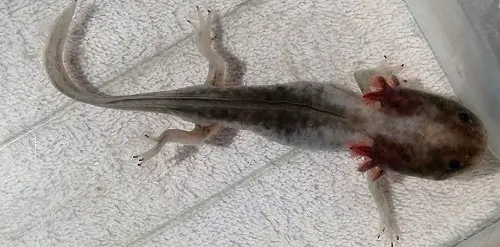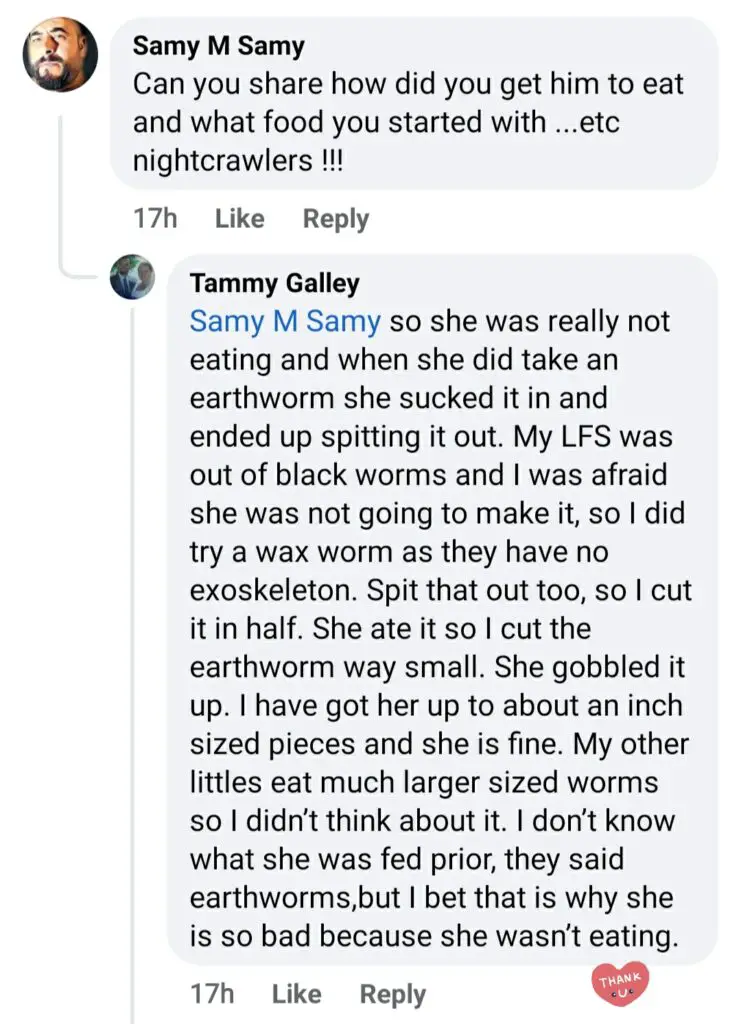- The 13 most Common Axolotl diseases , their Symptoms and Treatments
- 1- Axolotls may suffer from Amputations and Injuries
- 2- Uncontrolled Floating :
- 3- Bowel Blockage and Impaction :
- 4- Infections and Mycosis in axolotls
- 5-Anchor worms ( Lernaea )
- 6-Red Legs Syndrome
- 7-Anorexia and intestinal worms
- 8-My axolotl has an abscess ” bump” on the head !
- 9- Fluid accumulation (Edema and Ascites), and abnormal cell growth (Tumors).
- 10- The Chronic Stress
- 11-Axolotls can get Tumors ?
- 12- Neurological disease in axolotls
- 13- Buoyancy disorders in axolotls
- Answering some of your questions about axolotl illnesses :
- Malnourished axolotl : How to save an anorexic axolotl ?
The 13 most Common Axolotl diseases , their Symptoms and Treatments
When you choose an axolotl as a pet, it is necessary to set up a tank especially for it by trying to reproduce as faithfully as possible its natural environment, if not your axolotl will not delay to fall ill, here are the known diseases in axolotls and especially the symptoms in order to act at the right time if that were to arrive.
Common axolotl diseases are blockage and impaction, abscesses, red legs syndrome , injuries and amputations, chemical or ammonia burn , stress , water retention and floating, anorexia ,bacterial or fungal infection, worms and other parasites like anchor worms .
As you can see, the list of axolotl illnesses is quite long, but don’t worry , axolotls are beginners friendly pets and if you take good care of it, none of this issues will happen to your axolotl, but it’s always good to know these axolotls diseases, especially their symptoms, and what to do to treat them yourself when it’s possible or get to the vet in some severe cases .
Let’s dive in …
1- Axolotls may suffer from Amputations and Injuries
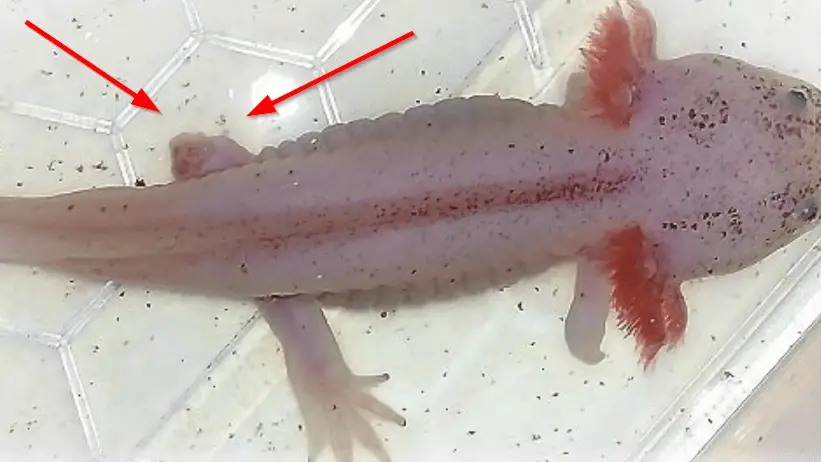
We will start with this problem in axolotls ; in fact it is not rare to see an axolotl missing a leg, a piece of its gills, the end of the tail, a piece of its lip …
This is usually due to cannibalism, and it happens when you put together, in the same tank, axolotls that have at least 2 inches of difference in size, and the larger can easily attack the smaller one.
The reason can be hunger, because an axolotl can eat its fellow axolotl, but also the fight of territory especially when the tank is too small for them and they can fight and injure each other also for the females.
If you notice that your axolotl is injured even if it is alone in the tank, check your decorations, its shelter may be a sharp edge … etc.
What to do?
Start by isolating the axolotl that was attacked and consider buying it a new tank, or give it to a friend once it has recovered and the part it was missing has regenerated.
To avoid this, it’s necessary to respect the rules of space and the size of the tank as well as the rules of good neighbourliness in the axolotls.
2- Uncontrolled Floating :
Excessive floating is very common in axolotls and due to gas buildup in your axolotl gut and your will surely experience it one day or another because the reasons of uncontrolled floating might be :
- Stress due to bad water quality ( Ammonia/Nitrites spike ) caused by an increased feeding rate or stocking density , damaged filter , crashed cycle .
- Food indigestion ( Bloating )
- Overheating ( too hot tank water )
- Intestinal occlusion ( constipation )
- Impaction (gravel swallowing or too big pellets )
- Excessive air gulping
- leftover food ( pellets ) rotting in the tank
- Irregular feeding schedule .
- An axolotl that stays too much on top of the Bubbler ( air bubbles swallowing )
- Air swallowing while feeding
What to do about floating ?
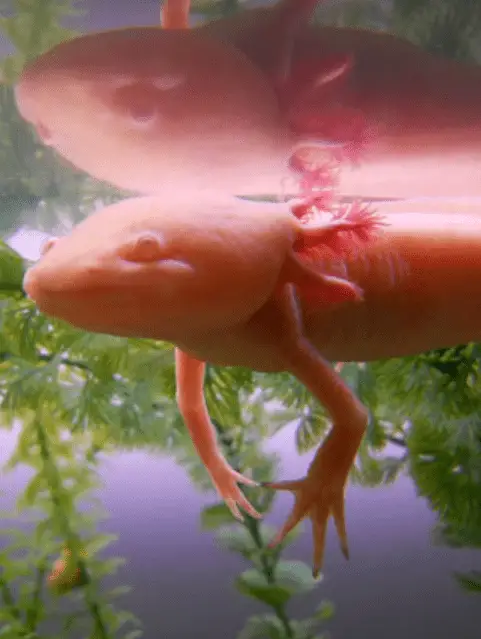
In fact, if your axolotl starts floating suddenly and cannot join the bottom of the tank in spite of all its efforts, tubbing ( not Fridging ! ) may be necessary , put it quickly in a container with an air stone and a small volume of fresh water so that the legs of the axolotl can touch the ground and that it calms down and rests.
Leave it in this tray until it deflates, just add a little water to the tray and see if it still floating !!
At the same time , take your liquid test kit and check your parameters, the level of Nitrites and Ammonia should be 00 ppm , Nitrates, this one must be less than 60 ppm, Successive water changes may be necessary to re-establish a nitrogen cycle.
If there is another axolotl in the tank, check if it is not the one that is stressing it.
Soaking pellets before feeding them may also be the solution but don’t force-feeding them when they’re bloated .
If finally your axolotl is slow to deflate, more than 2 days, I advise you to take it to a vet that specializes in amphibians, it may be suffering from an intestinal occlusion.
3- Bowel Blockage and Impaction :
As its name suggests, intestinal occlusion or bowel blockage in axolotls is a problem that occurs when the GI tract of this adorable little monster gets clogged !
If your axolotl suffers from bowel blockage, it is probably due to its food. Some worms like mealworms and wax worms can cause a bowel blockage if you don’t remove the worm heads or give your axolotl large worms or more than enough!
Feeding bad quality pellets or un-soaked pellets can also create a GI tract blockage. The same problem occurs when your axolotl eats live fish or several small crustaceans in one meal, their shells can create a clump in its digestive tract and cause bowel blockage.
In case of a gastrointestinal foreign body that causes impaction , the ingestion of gravel or a small piece that comes off one of the decorations and live plants is often what causes this issue .
That’s why I recommend bare bottom , or to use as substrate only smooth river sand and rocks bigger than the head of your axolotl .
The symptoms are :
- Axolotl ignoring its food
- He will bend over himself
- Uncontrolled floating
- You can even see the small pebble if it is a young axolotl , still half transparent like albinos.
What should I do if my axolotl has a bowel obstruction?
Not much generally, but you can stop feeding it, and if it doesn’t evacuate the gravel for 2 days, you should consult a veterinarian.
A professional massage of the axolotl’s belly can help solve the problem, if not, only surgery can remove the object swallowed by the axolotl or the pile of undigested bones and shells.
Some prescribe Paraffin or castor oil , mineral oil , it will act like a lubricant to help your axolotl to pass the waste/blockage before the food starts rotting in its gut.
In case of impaction, Fridging your axolotl can lead it to regurgitate the swallowed object before it goes into a state of pre-hibernation.
Before anything else, I advise you to check the inside of your axolotl’s mouth and throat, you can do it yourself and remove the object that caused the impaction if it is still in its mouth and has not yet passed into its stomach.
How to avoid Bowel blockage and Impaction in axolotls?
You should avoid using gravel as substrate ; and if you do put some in anyway, at least get into the habit of feeding your axolotls on a clear glass plate or bowl that you put at the bottom of the tank slowly after you put the axolotl food in it. By doing so, they cannot suck up gravel with the food.
- Always check your tank to see if a plant has dropped a leaf or stem on the bottom of the tank.
- Remove mealworm heads and avoid wax worms.
- Remove shrimp shells, fish bones and heads before feeding them to your axolotl.
- Split the large pellets before feeding them to your axolotl.
4- Infections and Mycosis in axolotls
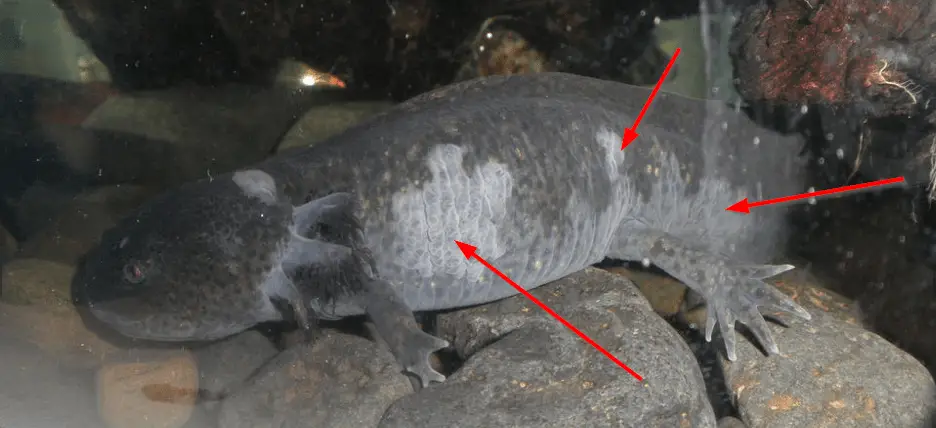
Mycosis is a kind of fungus ( Columnaris or Fungus / mold Saprolegnia ) that appears in a cottony form, usually attached to the gills or in the form of dark patches on your axolotl skin.
What causes Fungal Infection ?
- Poor maintenance of the tank
- Degradation of water quality, Fungus will never grow in a clean tank.
- Rotting of leftover food, poop or dead leaves from living plants.
- The introduction of a tank mate or an element of decoration or plant infected with Fungus.
- Using a media from a Fungus-infected tank to initiate the cycling process
Can I use Salt Baths to treat Fungus?
First, even though axolotls can tolerate a little salt in the water, salt baths (even using aquarium salt for only 10 minutes) can be very stressful for them and this practice will weaken their immune system just when they need it most! So avoid salt baths because even though this will kill the Fungus, it will also harm your axolotl.
Is FURAN-2 or Peroxide swabs a good solution to treat Fungal infection ?
These products and chemicals are not tested for axolotls, they are made to treat infections in fish.
Don’t add chemicals to your axolotl’s tank without the advice of a vet.
Also avoid trying to remove the cotton-like tufts from the body and gills of your axolotl yourself, it is painful for the axolotl and it will fall off after treatment. Vets are using anesthesia before doing that .
How to treat Fungus infection ?
Before using products like MinnFinn, which is often effective even though it is designed to treat fish and not axolotls, I recommend that you don’t use anything chemical, just successive water changes.
First, Tubbing your axolotl .10 to 15 minutes ( Black tea bath) ( effective just at the beginning of the infection ) and to prevent the infection to become internal .This is known to help coat regeneration in axolotls and prevent Fungus to infect eventual wounds or injuries invisible to the naked eye .
And than , operating daily water changes (25% to 30%) for one to two weeks and if you can get from an axolotl owner some cycled water , you will also use it to wash the tank elements and the substrate because fungus may have already infected the whole tank .
You can also use Indian Almond Leaves during the first water changes to accelerate the treatment.
Don’t forget to clean the filter and replace the Media.
Other Axolotl Skin Conditions:
The symptoms
Bacterial dermatitis: Redness, inflammation, or swelling on the skin.
Ulcers: Open sores or wounds on the skin surface.
Lesions: Abnormalities or irregularities in the skin texture.
The Causes:
Bacterial dermatitis: Poor water quality, injuries, or stress.
Ulcers: Physical injuries, poor water conditions, or bacterial infections.
Lesions: Trauma, bacterial or fungal infections, or environmental stressors.
The treatments
- Maintain clean water conditions through regular tank maintenance.
- Treat bacterial infections with antibiotic medications prescribed by a veterinarian.
- Provide a stress-free environment with appropriate hiding spots and water parameters.
Intestinal worms and parasites in axolotls
Axolotls can also get harmful intestinal parasites like Hexamita, Opalina, Trichodina and Ichthyobodo by hunting already infected tank mates or by eating contaminated food.
You should always quarantine the tank mates before introducing them into the tank and make sure the worms and pellets are fresh before feeding them to your axolotls.
Other Parasites and axolotl bacterial infections
1- Ciliates (Ciliophora)
Ciliates are common ectoparasites in axolotls and cause clinically manifest diseases especially in mass infestations due to overstocking, poor water quality or other stress influences.
In addition to the freely movable ciliates, sessile forms occasionally occur. These are also found on eggs and larvae, they are mainly detected on the gills, cloaca, or external skin.
Infestation with sessile ciliates can lead to the formation of cotton ball-like coatings, which are often misinterpreted as “fungal infestation” . Massive infestations can lead to hemorrhagic and necrotizing inflammation of the skin and gills.
The symptoms should be :
- Color changes of your axolotl skin
- Increased shedding of the skin
- Plaque formation and gill inflammation (necrosis)
- Stress and restlessness
- Inappetence
How to get rid of this infection ?
Treatment of ciliate infestation consists primarily in eliminating the factors and husbandry deficiencies that promote infection. Baths in distilled water, salt baths, dye solutions or formalin treatment are possible (ask your vet for more advice ) .
2- Spironucleus spp
Spironucleus elegans (Diplomonadida: Hexamitidae) are occasionally found in skin and gill swabs .These parasites have been detected particularly when axolotls are kept together with fish . Infected axolotls may get kidney disease .
3- Ichthyobodo spp (Ectoparasitic flagellates)
Costia necatrix parasites can be detected in masses, especially with overstocking and poor water parameters .The common symptoms are increased slime formation on the axolotl body surface, plaques, detachment of skin fragments and necrosis .
4- Adhering bacteria (Aeromonas hydrophila)
Fridging the axolotl, which is usually carried out by axolotl keepers, does not lead to control in this case, but supports the reproduction of the protozoa. Only higher temperatures can prevent reproduction and kill the pathogen.
The optimization of the husbandry conditions is a basic prerequisite for therapy, which in this case should take the form of salt and/or dye baths.
Most of these infections and parasites can be avoided by following three rules:
1- The tank water and its temperature must be constantly checked and rectified if necessary
2- Never introduce a new decorative element, plant or other tank mate before checking its provenance and quarantining it to avoid any contamination of the tank and your axolotl.
3- Always check your axolotls for signs of infection, especially when they are injured, and directly quarantine affected or suspect specimens .
5-Anchor worms ( Lernaea )
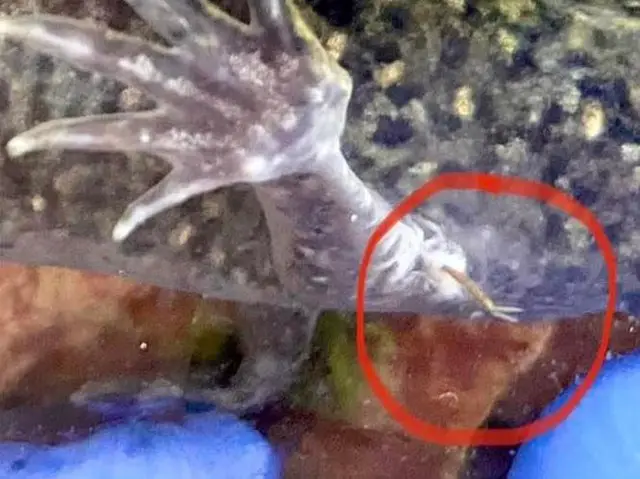
Anchor worm is a small Parasite, not larger than one and a half mm, usually of white or red color whose females of this parasite will cling after mating to the gills and on the skin of the axolotl and to feed there.
Anchor worms infection symptoms
- Adult Anchor worms are visible to naked eye
- External hemorrhage and probable sores where the worms are anchored.
- Loss of interest in food
- Excessive scratching against the scenery to detach these parasites
What to do about anchor warms?
NOTE: I have not tested the two chemical treatments that follow (this is just a result of personal research and testimonials) and in my personal opinion, removing the adult anchor worms, lowering the tank temperature and changing the water will be sufficient to eliminate the anchor worms and their larvae, but this is a solution that will take several months.)
Adult anchor worms are removed manually under anesthesia .
The areas where the anchor worms are attached will be disinfected, probably with Betadine to avoid secondary infections but especially to eliminate any fertilized Lernaea eggs and get rid of the anchor worms.
To treat the tank and get rid of Lernaea Infection without having to change all the water and without doing a complete cleaning (of the tank, substrate and decorative elements and filter) with a mixture of water and white vinegar, which will force you to tubbing your axolotl and several days to recycle the water of the tank, you can simply use either :
1- Either you treat the water with Lufenuron (0.1mg/L) once a week for a few months (5 to 6 months) (tested in laboratory on axolotls tanks)
2- Or you treat the tank with Dimilin powder ( 1 gram per 1000 liter ) ( 0.15 gr/ 40 gallon tank ) , 2 treatments in two weeks ( tested only on fish … ask the vet before using it and use it carefully after quarantining your axolotl ) .
Preventive treatments against anchor worms twice a year.
To speed up the process of anchor worm eradication from your axolotl tank, you will also:
Make water changes of 25% to 30% every two to three days while checking the filters and elements of the tank and plants to capture any adult anchor worms visible to the naked eye.
Set up a Chiller to lower the tank temperature to about 60°F (17 or 18°C) to prevent anchor worms from breeding and their larvae from thriving in the tank (they hate low temperatures).
How to avoid anchor worms ?
It is always necessary to check the small fish that you use as food for your axolotl as well as the shrimps, to put in quarantine any fish of cold water (favorite medium of this parasite) and to check it before introducing it in the tank of your axolotl.
6-Red Legs Syndrome
As the name suggests, this axolotl skin condition is deadly and highly contagious bacteria when it infects an axolotl, red spots will appear on its body and its legs will turn reddish before it spreads throughout the axolotl’s body and will in most cases cause its sudden death, as it is usually detected too late to be treated.
Other symptoms of red legs disease ( Aeromonas hydrophila ) are bleeding from the eyes and skin, open sores on the skin , severe anemia and weight loss, and the axolotl will suffer from some kind of lethargy.
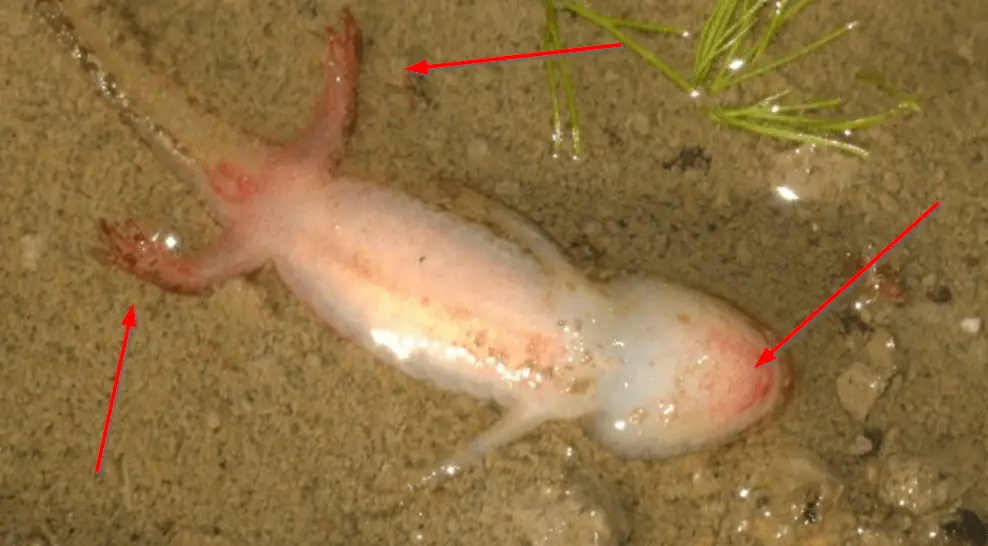
What can be done about it?
If there are other axolotls in the tank, take them out immediately and put them in separate containers.
The affected axolotl must immediately see a vet , medical baths may be necessary and an antibiotic will be injected to get rid of the Bacterial Dermatosepticemia , he will be able to save it but at an advanced stage, this disease is incurable, you must also expect your axolotl to die !
How to avoid Red Legs Syndrome ?
It is a bacterium carried by other amphibians, so avoid introducing another axolotl in the tank before it spends a week under observation in a separate tank or another tank.
7-Anorexia and intestinal worms
If your axolotl is anorexic, this means that it is getting thinner and thinner and will soon die from it !
The symptoms are clear, a thin axolotl, which refuses to knot and which has difficulty to move.
The cause could well be either, an unsuitable food, you may not have succeeded in making it pass from bloodworms to pellets and it refuses to eat them, or your pellets are too big and it can’t swallow them ….
Poor tank maintenance can also trigger this problem, dirty water can force the axolotl to regurgitate its food and become anorexic over time.
Intestinal worms can also cause anorexia in your axolotl because they will feed on what they ingest and will leave nothing of the food they digest.
What to do?
See a vet to confirm this diagnosis and he will surely tell you to take care of the tank, use appropriate pellets (size and quality) and live earthworms to feed your axolotl.
8-My axolotl has an abscess ” bump” on the head !
Yes, it can happen that an abscess forms on the head of your axolotl if it has just injured itself inside its oral cavity (in the mouth).
A tooth that gets infected can cause this, a food that he has just eaten and that cuts his cheek from the inside like the tail or the slightly sharp flipper of a guppy … etc…
Abscesses can also form on the head of an axolotl when it abruptly hits an element of the scenery or the tank walls, this can happen during altercations with an aggressive tank mate.
What to do about abscess ?
A visit to the vet is advisable in this case, but basically you have to isolate the axolotl until the bump (abscess) disappears on its own, after the wound in the mouth has healed and then disinfect the area of the abscess, with a colloidal silver bath to avoid over-infection of the area. if I remember correctly, but you have to ask your vet for more advice on this.
9- Fluid accumulation (Edema and Ascites), and abnormal cell growth (Tumors).
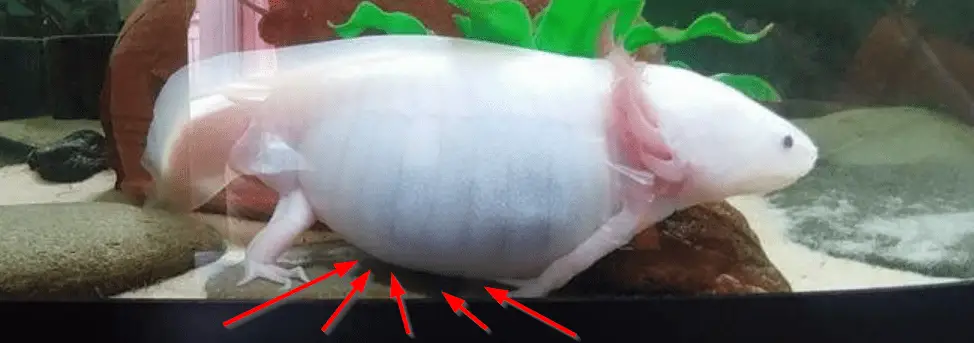
Fluids that build up in a kind of pouch that appears on your axolotl can be caused by a lack of nutrients, kidney problems or even heart damage and old age generally.
But these kinds of problems are usually due to a genetic abnormality, so there is nothing you can do about it, and only your veterinarian can tell you more if this kind of health problem appears on your axolotl.
Fluid retention in axolotls occurs when the body is unable to retain fluids in the vessels and some damaged organs (usually heart & lever failure).
Dr. Bree Talbot of Wildlife Hospital (Australia), also found after analysis of an X-ray done on an axolotl suffering from this disease, that fluid retention was also associated with “poor bone density and some changes to the skeleton suggestive of metabolic bone disease”.
According to The Journal of Veterinary Medical Science, Hydrocoelom has no known cause other than organ failure but the rise in temperature is a risk factor for hydrocoelom. Tanks without substrate (bare bottom) have also known several cases of Hydrocoelom.
Hydrocoelom is more common during the warm season (June) and may be due to the instability of the water temperature which may have peaks during the day and then become cooler at nightfall, which is why watercooling equipment such as a chiller is recommended if the temperature of the room can fluctuate rapidly and successively during the day.
Respiratory Infections
Respiratory infections can also severely impact an axolotl’s health and require prompt attention to prevent further complications.
Symptoms:
Labored breathing or gasping at the water’s surface.
Excessive mucus around the mouth and nostrils.
Lethargy or reduced appetite.
Causes:
- Poor water quality, leading to bacterial or fungal growth.
- Exposure to environmental toxins or irritants.
- Stress from overcrowding or aggressive tank mates.
Treatment:
- Improve water quality through regular water changes and filtration.
- Administer antibiotic medications prescribed by a veterinarian to treat bacterial infections.
- Provide a stress-free environment with optimal water parameters and sufficient oxygenation.
What can be done to avoid this?
If it’s due to bad genes, nothing ! sorry but if your axolotl is malnourished, you must remedy it by varying its food, not only give it earthworms, you also need balanced pellets n a little bit of fresh water fish flesh and make sure that the water has the recommended hardness and contains the right amount of mineral salts.
10- The Chronic Stress
This is probably the most common problem among owners of axolotls, these small pets, are often victims of stress, because there are many reasons, let’s start with the symptoms you will see in a stressed axolotl:
- Gills bent forward
- Gills turning bright red
- Floating
- An axolotl that stays in its shelter even at night.
- An axolotl that refuses to eat
- A hyperactive axolotl that hits its snout on the walls of the tank
- An axolotl that comes to the surface too often
There are still some, but these symptoms are the most common when talking about stress in axolotls.
The causes of stress are also numerous and include the following:
- A dirty tank
- A pump that is too noisy
- Too hot water
- A filter that does not work well or that creates a strong current in the water ( bad filtering system ) .
- Toxic water overloaded with nitrates, nitrites and ammonia.
- A larger or aggressive tank mate, when keeping more than one axolotl in the same tank .
- An incomplete nitrogen cycle
- Water that is too acidic and could also cause skin burns in axolotls.
What should I do if my axolotl is stressed?
Well, the answer is quite clear, it is necessary to avoid causing it by making sure that your axolotl lives in a tank well prepared and made especially for axolotls, spacious and calm without too many swirls or lights.
Take care to feed and take care of your axolotl, also think of varying its diet …
11-Axolotls can get Tumors ?
Axolotls can get cancer, but only the vet can confirm if that bump, wart , skin bruise or small pimple on the head or on your axolotl body is just a cyst (cephalic subcutaneous abscess ) or a tumor, usually benign and rare in axolotls and in some cases like Cutaneous masses, surgical removal might be the best way to solve the issue , Radiotherapy treatment may also follow the removal of masses like in case of ( olfactory neuroblastoma ) an intraoral mass .
Thanks to their ability to regenerate, axolotls have developed a great resistance to cancer, each dysfunctional cell is replaced by a new and healthy one. That’s why tumor cases are very rare in axolotls.
According to the study done by Veniamin V Khudoley and and Valery V. Eliselv , “ Multiple melanophoromas In the axolotl were characterized by cell anaplasia and polymorphism. Pigment spots may be the first stage of tumor development. Spontaneous pigment cell tumors in axolotls have not often been reported ”
Axolotls can also get tumor of the testis identified by neoplasms in the testis of the axolotl .
12- Neurological disease in axolotls
Unfortunately there has not been much work and research on Neurological disease in axolotls because the reported cases are very rare. Axolotls may in some rare cases suffer from certain diseases like :
- Forelimb paralysis
- Malignant olfactory neuroepithelioma
- Torticollis ( head tilts) in axolotls
13- Buoyancy disorders in axolotls
In this case bloating and floating are the two main symptoms because this disease is caused by the accumulation of free air within the axolotl’s body cavity.
This disease can be caused by pulmonary disease, as well as neurological disease. Lung perforations or lung lesions can also cause this disease in axolotls that have sensitive skin and thus let air penetrate the body cavity from the lungs.
To avoid these types of problems, avoid decorating your axolotl tank with items that have sharp edges or dead wood that may hurt your axolotl.
Also, avoid introducing into the tank species that are not safe for axolotls, especially fish that have backbones.
Answering some of your questions about axolotl illnesses :
Hello!
I just read your blog about common axolotl illnesses. I was hoping you might be able to help me out,
I have no idea what’s going on with my axolotl. His name is Jabbers and he’s about 3 years old.
About a month ago he suddenly developed white spots on his skin, but they don’t look like fungus to me.
They haven’t really spread more than what they are now. I cleaned his tank completely and put in freshly cycled water.
He got suddenly skinny when the spots appeared, but he has been eating well the entire time.
Now, overnight, his gills got like a thousand new fluffy strands. They keep changing from pale/clear to a dark pink.
I don’t have any vets near me with training for my poor bean, so if you have any suggestions for me, I will gladly take them. I’ve included a few pictures of him for your reference.
Thank you so much for your help and time!
Alexandra H
This answer could help :
I think that you are using some saltwater tanks ornaments .
As you know they are freshwater , it should not have ornaments of marine origin because they raise the hardness of the water.
If it’s the case , remove those ornaments and try to feed it with live bugs.The best way for them to recover quickly is to feed them live worms.
It could be ammonia burns , in this case you will need to :
Use freshwater test kit to monitor the water (PH … etc)
Make water changes, 3 in a row of 40%, one per day.
Siphon its feces.
Change with water at the same temperature and without chlorine.
Then 2 changes of 50% per week and every month a total water change.
This kind of stuff also happens when the cat often drinks from the aquarium!! it can easily infect the water!!
So if you have a cat, keep it away from the tank
I’m really sorry for what happened to your axolotl, unfortunately I’m not a vet and I don’t have much experience with axolotls
Since it’s not fungus, that’s all I can think of! the water quality, try to test the water and change it more often, check the filter if it’s working too. Always Sniff out the waste and the food leftovers….
Concerning the color change of the grills, do not worry, it just reflects its mood, pale yellow that is to say your axolotl is relaxed and red when it is attentive, curious, in hunting mode, angry … etc
Malnourished axolotl : How to save an anorexic axolotl ?
If you have found or bought an anorexic axolotl, and you want to save it and help it to regain its ideal weight, you will follow these steps:
1- Take the axolotl to the Vet so that he can examine it and verify that it does not suffer from a disease or an intestinal obstruction that prevents it from eating. It may have intestines obstructed by a stone or an agglomerate of bones if it has swallowed a fish at its previous owner’s house and has badly digested the bones … etc
PH, bad water quality, parasites , pimples ,abscess, worms on the gills, stress or an aggressive tank mate could also be the source of his anorexia.
2- Prepare a small container to keep your axolotl in , put it in a quiet room that can be plunged in the dark. check water parameters before introducing the axolotl.
Put in just one shelter, a substrate and just enough water to keep the axolotl alive, you will also change the water every day.
You can’t put this anorexic axolotl directly into a tank because it’s easier to handle, monitor and help it feed in a small container.
3- Prepare earthworms or nightcrawlers (very nutritious and they will help your axolotl to regain weight and heal quickly) and frozen bloodworms as well as Hikari pellets and beef heart that you will cut into smaller pieces in case your axolotl refuses to eat the worms.
Using aquarium tweezers, start by giving the malnourished axolotl small pieces of earthworms (3 to 5 mm) that you will shake in front of its nose until it decides to eat them.
The smell will surely whet its appetite, you can also use pieces of blackworms, they also smell stronger and can also push the axolotl to feed.
You can also try to put some bloodworms in front of your axolotl, at night, don’t put a lot of them so that you know if your axolotl has eaten them or some of them.
If your axolotl refuses to eat the pieces of earthworms and bloodworms, try beef heart or Hikari pellets, it may be his usual food!
Usually axolotls accept to eat the pieces of earthworms, in this case, you will increase more and more the length of the pieces of earthworms as your axolotl recovers its strength.
When you see that your axolotl starts to move in the container, and it has recovered some weight (this can take up to 30 days when the anorexia is severe), do not rush the process and be patient.
You will then put your axolotl in the tank and continue to give him complete and live earthworms until he becomes normal again. Try also small pieces of Beef heart meat , this will help him to recover quickly.
PS: if you notice white poop, stop giving him beef heart (a little fat) and continue with worms and Hikari pellets.
You can then give him other foods, why not live freshwater fish or shrimp to vary his menu.
Know that some malnourished axolotls unfortunately arrive at points of no return, that is to say, you can no longer save them even with force-feeding , so do not feel too guilty if you try everything but your axolotl still refuses to feed, so let him go in peace, in the axolotl paradise.
Wax worms could also help an anorexic axolotl to start eating
I asked a friend how he saved an anorexic axolotl :
So she was really not eating and when she did take an earthworm she sucked it in and ended up spitting it out.
My LFS was out of black worms and I was afraid she was not going to make it, so I did try a wax worm as they have no exoskeleton. Spit that out too, so I cut it in half.
She ate it so I cut the earthworm way small. She gobbled it up. I have got her up to about an inch sized pieces and she is fine. My other littles eat much larger sized worms so I didn’t think about it.
I don’t know what she was fed prior, they said earthworms,but I bet that is why she is so bad because she wasn’t eating.

